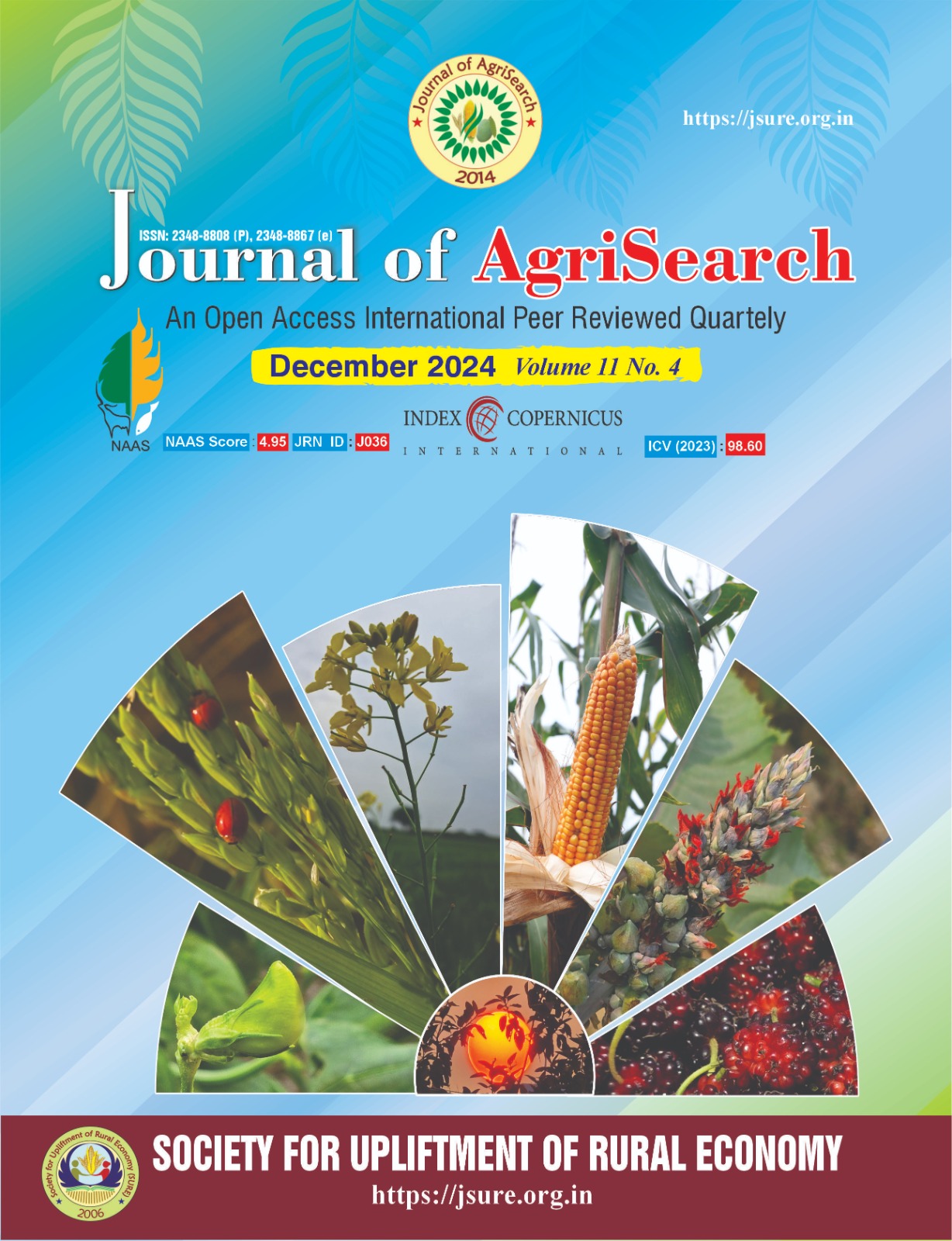Fecal hormonal dynamics in the last month of gestation in a captive black one-horn rhinoceros (Rhinoceros unicornis): A case report
Gestational hormone profile in captive rhinoceros
DOI:
https://doi.org/10.21921/jas.v11i04.15220Keywords:
Rhinoceros, Gestation, Estrogen, Progesterone, Fecal metabolitesAbstract
One-horned black rhinoceros, also known as the Indian rhinoceros (Rhinoceros unicornis) is critically endangered due to poaching and habitat loss. The primary aim of this study was to investigate the levels of fecal progesterone and estrogen in the Indian great one-horned rhino during the last month of 472 days gestation and to observe the associated physical and behavioral changes. Notably, 48 hours before calving, estrogen levels increased by 234.56 ng/g, while progesterone levels decreased by 1034 ng/g. These hormonal changes provide critical insights into the physiological processes leading up to parturition, offering valuable information for the management of breeding programs for this critically endangered species in the wild and captivity.
References
Berkeley E, Kirkpatrick J, Schaffer N, Bryant W and Threlfall W. 1997. Serum and fecal steroid analysis of ovulation, pregnancy, and parturition in the black rhinoceros (Diceros bicornis). Zoo Biology 16:121-132. 10.1002/(SICI)1098-2361
Brown J L, Bellen A C, Fouraker M, Wildt D E and Roth T L. 2001. Comparative analysis of gonadal and ad renal activity in the black and white rhinoceros in North America by noninvasive endocrine monitoring. Zoo Biology 20: 463-486.
Catchpole H R. 1969. Hormonal mechanisms during pregnancy and parturition. RE PRODUCTION IN DOMESTIC ANIMALS, 2nd ed. H. H. Cole, P. T. Cupps, eds., London, Academic Press, 1969, pp. 423–425.
Dinerstein E. 2003. The Return of the Unicornis: The Natural History and Conservation of the Greater One-Horned Rhinoceros. Columbia University Press, New York, USA.
Garnier J N, Holt W V and Watson P F. 2002. Non-invasive assessment of oestrous cycles and evaluation of reproductive seasonality in the female wild black rhinoceros (Diceros bicornis minor). Reproduction 123: 877-889.
Hermes R, Göritz F, Streich W J and Hildebrandt T B. 2007. Assisted reproduction in female rhinoceros and elephants–current status and future perspective. Reproduction in Domestic Animals 42: 33-44.
Hermes R, Göritz F, Wiesner M, Richter N, Mulot B, Alerte V, Smith S, Bouts T and Hildebrandt T B. 2020. Parturition in white rhinoceros. Theriogenology 156: 181– 188. https://doi.org/10.1016/j.theriogenology.2020.06.035.
Hindle J E, Mostl E and Hodges J K. 1992. Measurement of Urinary Estrogens and 20-Alpha- Dihydroprogesterone during Ovarian Cycles of Black (Diceros-Bicornis) and White (Ceratotherium-Simum) Rhinoceroses. Journal of Reproduction and Fertility 94: 237- 249.
Kock N, Morton D and Kock M. 1991. Reproductive parameters in free-ranging female black rhi noceroses (Diceros bicornis) in Zimbabwe. Onderstepoort Journal of Veterinary Research 58: 55–57.
Kumar V, Sood S, Vasudevan K and Umapathy G. 2021. A practical method for storage, preservation and transportation of anuran urine samples using filter paper for hormone analysis. Methods X. (8): 101578. https://doi.org/10.1016/j.mex.2021.101578.
Kumar V, Manu S, Caroline K, Sekhar A, Mamta S K, Sandeep M W, Senthilkumaran B and Umapathy G. 2022. Discovery of 16-Androstenes (Androstenone and Androstenol), their synthesis pathway, and possible role in reproduction of mouse deer (Moschiola indica). Cells. 11(23): 3837. https://doi.org/10.3390/cells11233837
Kumar V, Reddy V P, Kokkiligadda A, Shivaji S and Umapathy G. 2014. Non-invasive assessment of reproductive status and stress in captive Asian elephants in three south Indian zoos. Gen Comp Endocrinol 201:37-44.
Patton M L, Swaisgood R R, Czekala N M, White A M, Fetter G A, Montagne J P, Rieches R G and Lance A. 1999. Reproductive cycle length and pregnancy in the southern white rhinoceros (Ceratotherium simum si mum) as determined by fecal pregnane analysis and observations of mating behavior. Zoo Biology 18: 111-127.
Schwarzenberger F and Hermes R. 2023. Comparative analysis of gestation in three rhinoceros species (Diceros bicornis; Ceratotherium simum; Rhinoceros unicornis). General and Comparative Endocrinology 334: 114214. https://doi.org/10.1016/j.ygcen.2023.114214
Schwarzenberger F, Rietschel W, Vahala J, Holeckova D, Thomas P, Maltzan J, Baumgartner K and Schaftenaar W. 2000. Fecal progesterone, estrogen, and androgen metabolites for nonivasive monitoring of reproductive function in the female Indian rhinoceros, Rhinoceros unicornis. Gen. Compar. Endocrinol 119:300-307.
Schwarzenberger F, Möstl E F, Palme R and Bamberg E. 1996. Faecal steroid analysis for non- invasive monitoring of reproductive status in farm, wild and zoo animals. Animal Reproduction Science 42(1–4): 515-526. https://doi.org/10.1016/03784320(96)01561-8.
Stoops M A, Campbell M K, DeChant C J, Hauser J, Kottwitz J, Pairan R D, Shaffstall W, Volle K and Roth T L. 2016. Enhancing captive Indian rhinoceros genetics via artificial insemination of cryopreserved sperm. Anim. Reprod. Sci. 172: 60-75. https://doi.org/10.1016/j.anireprosci.2016.07.003.
Talukdar B K, Bonal B S, Sharma A, Sarma K and Singh S P. 2020. Reintroduction of greater one horned rhino in Manas National Park, Assam, India - under Indian Rhino Vision 2020.
Umapathy G, Deepak V, Kumar V, Chandrasekhar M and Vasudevan K. 2015. Endocrine profiling of endangered tropical chelonians using noninvasive fecal steroid analyses. Chelonian ConservBiol 14:108-115.
Downloads
Published
Issue
Section
License
Copyright (c) 2024 Bibha choubey, Stuti, Prasad, Amit, Shahla Yasmin, Dr. Ramesh Tiwary Tiwary, Dr Akhilesh Pandey

This work is licensed under a Creative Commons Attribution-NonCommercial-NoDerivatives 4.0 International License.
Publisher and Authors

